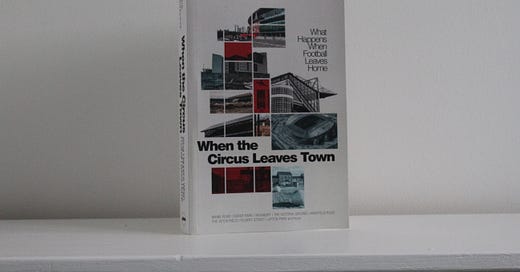Book Review: When the Circus Leaves Town by David Proudlove
A comprehensive jaunt into the effects of football clubs moving home
I was delighted when I first saw David Proudlove announce this release on Twitter. As is evident from following him on social media, I knew this wouldn’t be ‘just another football book’, but a comprehensive jaunt into the wider socio-economic, architectural, political and cultural spheres that a football club brings to its community - and the potential devastation it leaves when it vacates. I wasn't displeased. Far from it, and as it goes he has produced a gem of football's past and present, in addition to a map of its future.
Not dissimilar to the way in which Proudlove owes his passion for football to his Dad, I took this book with me when I next popped around to my own old man’s house. As the Amazon packaging was quickly tossed aside, a quick initial rummage hurled us both into a whim of nostalgia: reminiscing, moaning, swearing, laughing, shouting. All the emotions one feels on the terraces, and especially the negative ones if your club is from the Potteries, whether red and white or black and white.
The conversation was animated. Games of the past both good and bad, grounds we'd visited, open terraces stood on in the pissing rain, the smells, the sights, the sounds, the fans. Football and everything else that came with it, like Dave and so many others, has always been an extremely significant part of life. And as I began to read further, here was Proudlove encapsulating it all perfectly: 'I began to understand that football grounds weren't simply places where people went to watch the game'.
When The Circus Leaves Town provides fascinating insight into the wider thematic roots and subsequent impact of a football club moving home. It explores the underwhelming and often disgraceful impact of what is left behind. Equally, it also reveals a distinct lack of creativity, care or thought from policies, councils, or housing development organisations in recognising their importance and significance to people and their community.
A recurrent theme therefore emerges in this respect, with many of the spaces that once held these football clubs facing similar fate. Sunderland's old Roker Park replaced by a 'one size fits all housing estate that is alien to its surroundings with no design rationale' is just one such example. And no more is this apparent than that of Proudlove’s beloved Stoke City. A walk around the old site of the Victoria Ground reveals a bleak reality: 'a harsh lesson in the city's recent socio-economic history, a walk characterised by a mix of empty shops and the awful tat - vaping paraphernalia, second-hand phones, artery-hardening fast food'. In political terms, a direct result of the Tory Austerity project.
In many cases, what once was the beating heart of a community now lies bereft. I've been to the Morrisons supermarket in Walsall on many occasions - completely unaware it was once the site of the old Fellows Park. It is a great shame, and as my Dad gravely echoed Proudlove's own poignant statement regarding Stoke's old territory: 'it is hard to believe I was standing where some of the great names of English football had done their thing'.
Alas, the book is a stark indication of carelessness in terms of what is left behind, with a swathe of former football club's homes replaced with 'identikit housing around a street pattern with clichéd names'. And plenty of the new grounds described in the book are also underwhelming, many belonging to a pattern of Taylor Report mediocrity, such as Scunthorpe United’s Glanford Park, to which Proudlove found 'tucked away at the back of a retail park, of which the arse has since fallen out'.
Nevertheless, fortunately it’s not all doom and gloom – and understandably football clubs move home for a variety of reasons. Sometimes it does work - in footballing terms Middlesbrough have had some good times at the Riverside after their move from Ayresome Park. If it is right for the team and the area, and the procedure of rehoming is organised and implemented well, it works - as seen with Hull City and the accompanying growth for the surrounding area. Granted, not every new stadium can be an architectural masterpiece as Proudlove rightly states, and for smaller clubs such as Doncaster Rovers, their new home serves its purpose well. Huddersfield Town have retained their town centre, in proximity with decent public housing close by, and Bolton Wanderers produced a fantastic new ground in the now-named University of Bolton Stadium.
The beauty of this book lies in the sheer amount of research and toil that's been implemented, which only heightens its authenticity. The fact that Proudlove has made the effort to visit old and new territories for himself and not relied on biased opinion is commendable. His writing style is succinct, hilariously sardonic, balanced, and informative, resulting in a highly enjoyable and effortless read.
A fantastic book - highly recommend whether you are a football fan or not.




